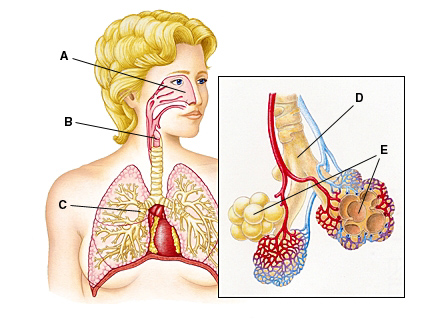In which of the following animals are the blood and the interstitial fluid considered to be the same body fluid?
grasshoppers
Which of the following best describes an artery?
Arteries carry blood away from the heart.
Organisms with a circulating body fluid that is distinct from the fluid that directly surrounds the body's cells are likely to have _____.
a closed circulatory system
In an open circulatory system, hemolymph is _____.
not always confined to blood vessels and is under lower pressure than in closed circulatory systems
Circulatory systems compensate for _____.
the slow rate at which diffusion occurs over large distances
Blood returns to the heart via the _____.
pulmonary veins
From the pulmonary veins, blood flows to the _____.
left atrium
From the superior vena cava, blood flows to the _____.
right atrium
From the capillaries of the abdominal organs and hind limbs, blood flows to the _____.
inferior vena cava
Carbon dioxide enters the blood at the _____.
capillaries of the head, forelimbs, abdominal organs, and hind limbs
The _____ has(have) the thinnest walls.
capillaries
Blood pressure is highest in the _____.
aorta

Most gas exchange with blood vessels occurs across the walls of the structure indicated by the letter _
E (Gas exchange occurs across the walls of the alveoli)
What is the function of a circulatory system?
It brings a transport liquid into close contact with all cells in the body.
Why do the circulatory systems of land vertebrates have separate circuits to the lungs and to the rest of the body?
The large decrease in blood pressure as blood moves through the lungs may prevent efficient circulation through the rest of the body.
True or false? The circulatory systems of land-dwelling vertebrates are composed of two pumping circuits: the systemic circulation, which is a lower-pressure circuit to the lung, and the pulmonary circulation, which is a higher-pressure circuit to the rest of the body.
False
What is the function of the left ventricle?
The left ventricle receives oxygenated blood from the lungs and pumps it to the rest of the body.
Which of the following statements about blood circulation in the body is true?
Valves prevent the backflow of blood into the atria and ventricles.
Which event occurs first during diastole?
The atria and ventricles are relaxed, and blood flows into the atria
Which event of the cardiac cycle occurs when systolic blood pressure is measured?
The ventricles contract, carrying blood into the aorta, and blood flows into the relaxed atria
Which of the following develops the greatest pressure on the blood in the mammalian aorta?
systole of the left ventricle
Which of the following is the correct sequence of blood flow in birds and mammals?
vena cava → right atrium → right ventricle pulmonary artery
A patient with a blood pressure of 120/75, a pulse rate of 70 beats/minute, a stroke volume of 70 mL/beat (milliliters per beat), and a respiratory rate of 25 breaths/minute will have a cardiac output of _____.
4,900 mL/minute
Damage to the sinoatrial node in humans _____.
would disrupt the rate and timing of cardiac muscle contractions
If a molecule of carbon dioxide released into the blood in your left toe is exhaled from your nose, it must pass through all of the following EXCEPT _____.
the pulmonary vein